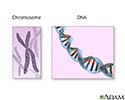Chromosome
Chromosomes are structures found in the center (nucleus) of cells that carry long pieces of DNA. DNA is the material that holds genes. It is the building block of the human body.
Chromosomes also contain proteins that help DNA exist in the proper form.
Chromosomes come in pairs. Normally, each cell in the human body has 23 pairs of chromosomes (46 total chromosomes). Half come from the mother; the other half come from the father.
Two of the chromosomes (the X and the Y chromosome) are called sex chromosomes, and in almost all people:
- Females have 2 X chromosomes.
- Males have 1 X and 1 Y chromosome.
At conception, the mother gives an X chromosome to the child, and the father may contribute an X or a Y. The chromosome from the father determines if the baby is female or male. In most cases, a child is born as a male or female according to their chromosomes. However, children with differences of sex development may be born with genitalia that do not match their chromosomes. Or they may have fewer or more than 46 chromosomes. All of these conditions can cause problems with sexual development.
The remaining chromosomes are called autosomal chromosomes. They are known as chromosome pairs 1 through 22.
References
Perle MA, Stein CH. Applications of cytogenetics in modern pathology. In: McPherson RA, Pincus MR, eds. Henry's Clinical Diagnosis and Management by Laboratory Methods. 24th ed. Philadelphia, PA: Elsevier; 2022:chap 71.
Taber's Cyclopedic Medical Dictionary. 24th ed. F.A. Davis Company; 2021. www.tabers.com/tabersonline. Accessed June 12, 2023.
Review Date: 4/27/2023
Reviewed By: Linda J. Vorvick, MD, Clinical Professor, Department of Family Medicine, UW Medicine, School of Medicine, University of Washington, Seattle, WA. Also reviewed by David C. Dugdale, MD, Medical Director, Brenda Conaway, Editorial Director, and the A.D.A.M. Editorial team. Editorial update 11/16/2023.



